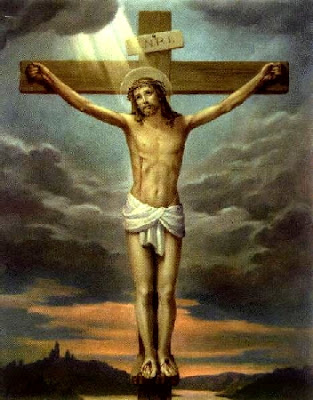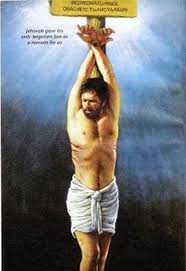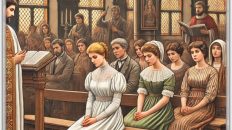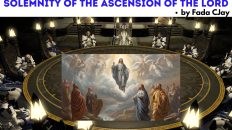THE DEATH OF JESUS: ON THE CROSS OR ON THE POLE/STAKE?
INBOX QUESTION:
“Kindly find time to provide an answer to this:
what is the shape of the wood on which Christ was crucified? A straight or
cross shape? Thanks as always
what is the shape of the wood on which Christ was crucified? A straight or
cross shape? Thanks as always
RESPONSE:
The “CROSS” is arguably the most beloved symbol of
Christianity. It is apparently seen in our Churches and Cathedrals, some homes,
schools, cemeteries, books, jewelleries, etc., and is used in numerous
marketing logos. For us Catholics, the crucified Christ is attached to our
cross and that makes more significant – a crucifix, casting our minds to the
event of our redemption – the holy death of Christ.
Christianity. It is apparently seen in our Churches and Cathedrals, some homes,
schools, cemeteries, books, jewelleries, etc., and is used in numerous
marketing logos. For us Catholics, the crucified Christ is attached to our
cross and that makes more significant – a crucifix, casting our minds to the
event of our redemption – the holy death of Christ.
However, this belief has been misinterpreted by the
Jehovah’s Witnesses. For them, Jesus did not die on a cross and that the cross is
in fact a pagan symbol; thus, rendering our use of the cross/crucifix absurd.
Put differently, Christ was not crucified according to the Jehovah’s witnesses;
he was only murdered on a “torture stake/pole”. This is exactly the stream in
which flows the question above.
Jehovah’s Witnesses. For them, Jesus did not die on a cross and that the cross is
in fact a pagan symbol; thus, rendering our use of the cross/crucifix absurd.
Put differently, Christ was not crucified according to the Jehovah’s witnesses;
he was only murdered on a “torture stake/pole”. This is exactly the stream in
which flows the question above.
The Jehovah’s Witnesses readily rely on the
ambiguity of the Greek word “stauros”. Although in Greek (Koiné Greek, which
the New Testament was written), the word stauros literally means ‘stake’, which
primarily denotes an upright stake or pole, etc. The word itself, therefore,
can be used for either shape piece of wood. If this is so, how do we come about
the “Cross”?
ambiguity of the Greek word “stauros”. Although in Greek (Koiné Greek, which
the New Testament was written), the word stauros literally means ‘stake’, which
primarily denotes an upright stake or pole, etc. The word itself, therefore,
can be used for either shape piece of wood. If this is so, how do we come about
the “Cross”?
To begin with, the word Crucify indicates: “to put
(someone) to death by nailing or binding them to a cross, especially as an
ancient punishment. Hence, arguing against the Jehovah’s Witnesses, if a stake
(that is, an upright pole) were used instead of a cross, then Jesus’ hands
would have been placed above His head with just ONE nail driven through His
wrists. Since the wrists would most likely overlap, only one nail is needed
through both wrists. But on the contrary, John 20:25 says: “So the other
disciples told him, ‘We have seen the Lord!’ But he said to them, ‘Unless I see
the nail marks in his hands and put my finger where the NAILS were, and put my
hand into his side, I will not believe.’” Notice the use of the word nails
(plural) in reference to hands (plural). It makes far more sense to say that
Jesus was crucified on a cross with outstretched hands and one nail in each
hands. Therefore, it is most logical to state that Jesus died on a cross with
outstretched arms. This also matches well with relevant archaeological
evidence. The remains of a crucified Jewish man named Yehohanon, who was
executed in the late 20’s A.D. (not long before Jesus) under the administration
of Pontius Pilate has been unearthed in a Judean tomb. Forensic analysis of the
remains indicates that he was crucified with his arms stretched apart. A nail
was found still embedded in his heel bone. All these details accord with the
description of the similar execution of Jesus under Pilate, and point toward a
cross shape rather than a single, upright beam or stake.
(someone) to death by nailing or binding them to a cross, especially as an
ancient punishment. Hence, arguing against the Jehovah’s Witnesses, if a stake
(that is, an upright pole) were used instead of a cross, then Jesus’ hands
would have been placed above His head with just ONE nail driven through His
wrists. Since the wrists would most likely overlap, only one nail is needed
through both wrists. But on the contrary, John 20:25 says: “So the other
disciples told him, ‘We have seen the Lord!’ But he said to them, ‘Unless I see
the nail marks in his hands and put my finger where the NAILS were, and put my
hand into his side, I will not believe.’” Notice the use of the word nails
(plural) in reference to hands (plural). It makes far more sense to say that
Jesus was crucified on a cross with outstretched hands and one nail in each
hands. Therefore, it is most logical to state that Jesus died on a cross with
outstretched arms. This also matches well with relevant archaeological
evidence. The remains of a crucified Jewish man named Yehohanon, who was
executed in the late 20’s A.D. (not long before Jesus) under the administration
of Pontius Pilate has been unearthed in a Judean tomb. Forensic analysis of the
remains indicates that he was crucified with his arms stretched apart. A nail
was found still embedded in his heel bone. All these details accord with the
description of the similar execution of Jesus under Pilate, and point toward a
cross shape rather than a single, upright beam or stake.
Another point in Matthew 27:37 reads “OVER HIS HEAD
they placed the written charge against him: this is Jesus, the king of the
Jews. Notice the word, “over his head”; this gives a proof that Christ was
crucified with outstretched arms, and the charge against him was placed over
his head. If he were to be murdered on a pole as claimed by the Jehovah’s
Witnesses, then Jesus’ hands would be above his head, and Matthew would have
recorded that the charge against him was placed over his hand, but this was not
the case. Also, Matt. 27:32,35 reads “And as they were coming out, they
found a man of Cyrene named Simon, whom they pressed into service to bear His
cross…And when they had CRUCIFIED Him, they divided up His garments among
themselves, casting lots…
they placed the written charge against him: this is Jesus, the king of the
Jews. Notice the word, “over his head”; this gives a proof that Christ was
crucified with outstretched arms, and the charge against him was placed over
his head. If he were to be murdered on a pole as claimed by the Jehovah’s
Witnesses, then Jesus’ hands would be above his head, and Matthew would have
recorded that the charge against him was placed over his hand, but this was not
the case. Also, Matt. 27:32,35 reads “And as they were coming out, they
found a man of Cyrene named Simon, whom they pressed into service to bear His
cross…And when they had CRUCIFIED Him, they divided up His garments among
themselves, casting lots…
In John 21. Jesus gives Peter a glimpse of the
manner of his death: “‘When you are old you will STRETCH OUT YOUR HANDS, and
someone else will dress you and lead you where you do not want to go.’ Jesus
said this to indicate the kind of death by which Peter would glorify God”
(verses 18–19). The fact that Peter (who tradition says was crucified) would
“STRETCH OUT” HIS HANDS indicates that Roman crucifixion usually involved
outspread arms such as would be positioned on a crosspiece.
manner of his death: “‘When you are old you will STRETCH OUT YOUR HANDS, and
someone else will dress you and lead you where you do not want to go.’ Jesus
said this to indicate the kind of death by which Peter would glorify God”
(verses 18–19). The fact that Peter (who tradition says was crucified) would
“STRETCH OUT” HIS HANDS indicates that Roman crucifixion usually involved
outspread arms such as would be positioned on a crosspiece.
The testimony of the early Christians also points
unanimously to a cross shape. A popular Christian writing of the early 100s
A.D. compares the cross to the Greek letter “Tau” which looks very
much like our “t”, and also speaks of the cross prefigured in Moses
stretching out his arms over the battle field of the armies of Israel. Even St.
Justin the Martyr/apologist (114-165 AD), who was from Samaria which is between
Galilee and Judea where most of Jesus own ministry took place, wrote that the
Passover lamb prefigured not only Jesus but also the cross, because: “The
lamb, which is roasted, is roasted and dressed up in the form of the cross. For
one spit is transfixed right through from the lower parts up to the head, and
one across the back, to which are attached the legs of the lamb”. There
are many arguments to counter the claim of the Jehovah’s witnesses; however,
let me stop here.
unanimously to a cross shape. A popular Christian writing of the early 100s
A.D. compares the cross to the Greek letter “Tau” which looks very
much like our “t”, and also speaks of the cross prefigured in Moses
stretching out his arms over the battle field of the armies of Israel. Even St.
Justin the Martyr/apologist (114-165 AD), who was from Samaria which is between
Galilee and Judea where most of Jesus own ministry took place, wrote that the
Passover lamb prefigured not only Jesus but also the cross, because: “The
lamb, which is roasted, is roasted and dressed up in the form of the cross. For
one spit is transfixed right through from the lower parts up to the head, and
one across the back, to which are attached the legs of the lamb”. There
are many arguments to counter the claim of the Jehovah’s witnesses; however,
let me stop here.
From what we have seen so far, we return to the
question above: “Was Jesus crucified on the Cross?” Yes! He was.
question above: “Was Jesus crucified on the Cross?” Yes! He was.
Therefore, portraying an insignificant detail of
biblical history, I dare to say that the Jehovah’s Witness’s literature is
entirely untrustworthy and unable to rightly handle the most basic biblical and
historical facts, and I strongly advise you to stop reading their books (e.g. My
Book of Bible Stories, Awake, Watch Tower etc.) These books have the potential
of influencing your faith negatively. I grew up reading the popular book called
“My book of bible story” by the Jehovah’s Witnesses (given to me by a neighbour
at a very tender age); I was misinformed that Jesus was crucified on a pole/stake
as indicated and illustrated in the book. Thank God, the mentality was erased
by my parents and also in the Catechism Class… Of course, their books appear to
be educative, but a careful examination of them shows how dangerous they could
be in jeopardizing your faith.
biblical history, I dare to say that the Jehovah’s Witness’s literature is
entirely untrustworthy and unable to rightly handle the most basic biblical and
historical facts, and I strongly advise you to stop reading their books (e.g. My
Book of Bible Stories, Awake, Watch Tower etc.) These books have the potential
of influencing your faith negatively. I grew up reading the popular book called
“My book of bible story” by the Jehovah’s Witnesses (given to me by a neighbour
at a very tender age); I was misinformed that Jesus was crucified on a pole/stake
as indicated and illustrated in the book. Thank God, the mentality was erased
by my parents and also in the Catechism Class… Of course, their books appear to
be educative, but a careful examination of them shows how dangerous they could
be in jeopardizing your faith.
I believe this question has been answered?
Shalom!





